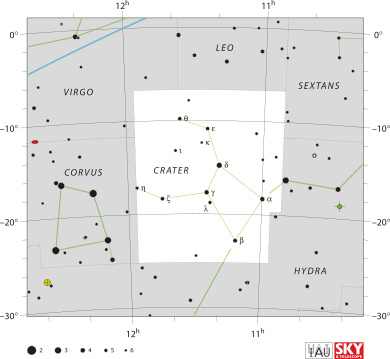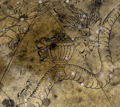Crater (constellation) facts for kids
| Constellation | |

List of stars in Crater
|
|
| Abbreviation | Crt |
|---|---|
| Genitive | Crateris |
| Pronunciation | genitive |
| Symbolism | the Cup |
| Right ascension | 11 |
| Declination | −16 |
| Quadrant | SQ2 |
| Area | 282 sq. deg. (53rd) |
| Main stars | 4 |
| Bayer/Flamsteed stars |
12 |
| Stars with planets | 6 |
| Stars brighter than 3.00m | 0 |
| Stars within 10.00 pc (32.62 ly) | 0 |
| Brightest star | δ Crt (Labrum) (3.57m) |
| Messier objects | 0 |
| Meteor showers | Eta Craterids |
| Bordering constellations |
Leo Sextans Hydra Corvus Virgo |
| Visible at latitudes between +65° and −90°. Best visible at 21:00 (9 p.m.) during the month of April. |
|
Crater is a constellation, which is a group of stars that form a pattern in the night sky. Its name comes from the Latin word for "cup." This constellation is linked to an old Greek myth involving the god Apollo. Crater was first listed by the ancient astronomer Ptolemy way back in the 1st century. Today, it's still one of the 88 officially recognized constellations. You can find Crater in the Southern Hemisphere of the sky.
The Story Behind Crater
The name "Crater" comes from an interesting Greek myth. In this story, the god Apollo had a crow or raven as his helper. Apollo sent the crow to fetch some water. But the crow got lazy and took a long time on its journey.
When the crow finally got the water in a cup, it tried to make an excuse. It brought back a water snake along with the cup, pretending the snake was the reason for the delay. However, Apollo saw through the crow's trick. He became very angry. In his anger, Apollo threw the cup, the crow, and the snake into the sky. That's how they became constellations.
The constellations of Corvus (the crow) and Hydra (the water-snake) are also part of this same ancient myth.
Images for kids
-
Crater as shown on The Manuchihr Globe, made in Mashhad in 1632-33 AD.
See also
 In Spanish: Crater (constelación) para niños
In Spanish: Crater (constelación) para niños



